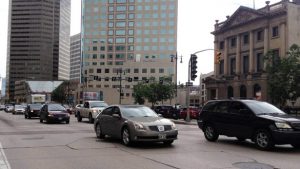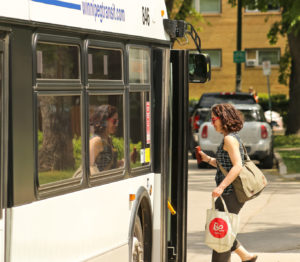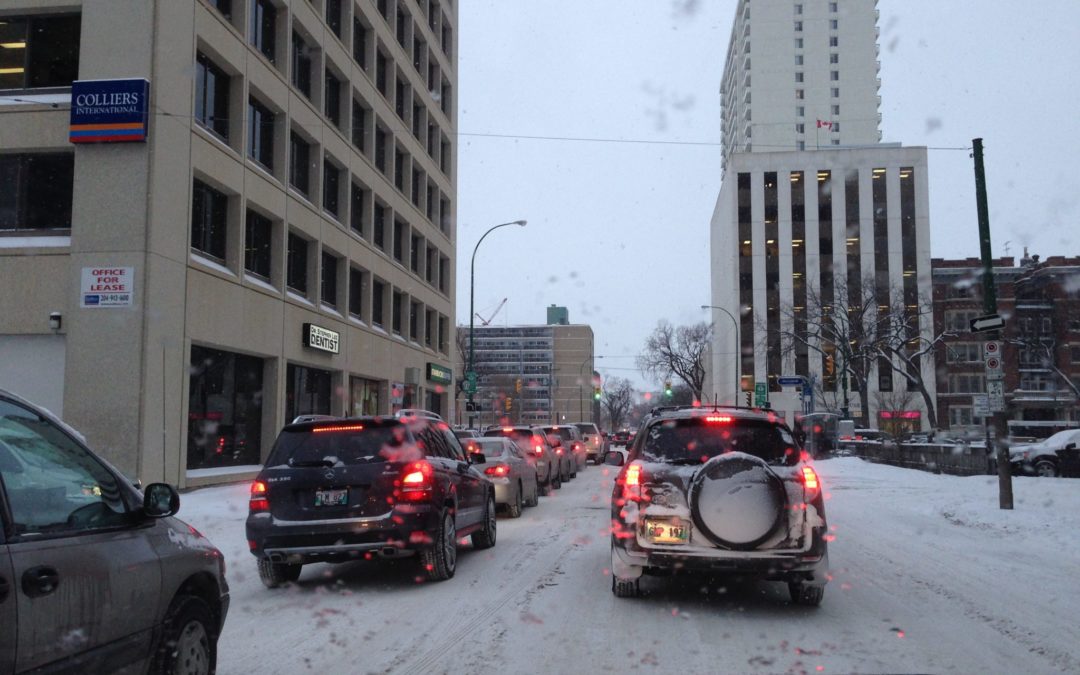As most Winnipeg citizens know, Mayor Bowman is a big fan of Uber and is keen to bring the service to Winnipeg. App-based services like Uber and Lyft function as ridehailing services, where customers request rides via their smartphones. Most of us have probably heard about the conflicts between the taxi industry and Transportation Network Companies (TNCs) as municipalities tackle their by-laws to welcome new for-hire services to their communities. Uber and Lyft are currently the most popular companies within the TNC market.
At Green Action Centre, we’re always keen to promote transportation choices that reduce the number of drive-alone trips. But are services like Uber and Lyft the right choice? What are the pros and cons, and how can our communities ensure they are prepared for the shake-up that TNCs will bring?
“UBER WILL REDUCE THE TRAFFIC CONGESTION IN WINNIPEG”
 Will Uber reduce the number of traffic jams? Logically, you would think yes, if more and more people choose to leave their vehicles at home and take an Uber, traffic and the resulting GHG (greenhouse gas) emissions will improve. The problem, though, is that the TNC system’s success relies upon there being enough vehicles on the road in each neighbourhood to pick up riders quickly. So, we will still see traffic from the Uber/Lyft drivers circling neighbourhoods waiting for their next fare (or idling in a nearby parking lot).
Will Uber reduce the number of traffic jams? Logically, you would think yes, if more and more people choose to leave their vehicles at home and take an Uber, traffic and the resulting GHG (greenhouse gas) emissions will improve. The problem, though, is that the TNC system’s success relies upon there being enough vehicles on the road in each neighbourhood to pick up riders quickly. So, we will still see traffic from the Uber/Lyft drivers circling neighbourhoods waiting for their next fare (or idling in a nearby parking lot).
It’s important to note the difference between “ridesharing” and “ridehailing” services to avoid companies that add to congestion and GHG emissions branding themselves as environmental. We, of course, encourage all citizens to sign-up for GoManitoba to access sustainable commuting choices in their area, like carpooling.
Currently, almost 80% of Winnipeggers commute in a car, with 71% of those people commuting alone. We’ve all sat in a traffic jam and understand the frustration of not being able to get to our destination on-time. This inefficiency is even more frustrating when you are commuting in a healthy, sustainable way on transit or a bike, but you are still stranded behind bumper-to-bumper vehicles. When you consider the available surface area of the road, and the space taken by one person in a vehicle, it’s easy to see why we are losing this #UrbanMath game in Winnipeg!
“UBER WILL SAVE WINNIPEGGERS MONEY”
A key marketing strategy for TNCs is their competitive rates compared to taxi services. But will Uber really save Winnipeggers money? We’ll have to see what the minimum rate per ride is here in Winnipeg, but a Consumer Report article last year did find that Uber was often not cheaper than taking a taxi (Uber vs. Taxi: Which Is Cheaper?) The key thing for consumers to be aware of is Surge Pricing. When demand is high, TNCs increase their rates. Since transactions are paid through the app, riders may be surprised when receiving their email receipts, like the Virginia woman who paid $640 for a ride to the airport. On the price-front, only time will tell. Buyer beware!
“UBER BRINGS AN EMPLOYMENT OPPORTUNITY TO WINNIPEG”
If you love to drive, what could be better than being paid to hit the road? TNCs attract drivers looking to supplement their income, and over half of Uber and Lyft drivers are over 50. But if you’re driving for a service geared to undercutting its rivals on fare rates, you may not make as much as a driver as you think… With these services, drivers are responsible for the gas and maintenance of their own vehicles, and you aren’t paid for the travel mileage or time to pick-up your customer. For a monetary breakdown on life as a TNC driver, check out Mr. Money Mustache’s entertaining post on his experience as an Uber driver.
“Imagine developing a company specifically to take advantage of people’s ignorance of how expensive it really is to drive their own car. What would this company look like?” … the answer is of course that it would look like very much like Uber or any other ridesharing [*ridehailing*] company.”
“UBER BRINGS MORE OPTIONS FOR WINNIPEGGERS”
Any Winnipegger who has waited (and waited and waited) for their taxi to arrive is keenly interested in more options for them to choose from. Taxi services are certainly far behind TNCs like Uber and Lyft when it comes to customer experience, although many taxi services have been improving their app service. The apps for Uber and Lyft are very user friendly: you can see the car you ordered on its way to you, giving you a real-time countdown, and the fare transaction takes place within the app. Once you reach your destination, just bid your driver farewell and you are on your way because the app arranges payment for you with your credit card details. Uber and Lyft are also efficient for those who are deaf or have other challenges with communication, since the app communicates your pick-up point and destination through the app itself.
But, will ALL Winnipeggers benefit? If you don’t have a smartphone, Uber and Lyft are out of your reach. Don’t have a credit card? This cashless system is not for you.
Also, are all neighbourhoods going to have equal access to Uber or Lyft? The answer is no. TNCs see their drivers as “partners” who choose their own hours and locations. Winnipeg is a city that struggles with poverty. Can we reasonably expect that Uber drivers will be keen to pick up riders in neighbourhoods that are more notorious for crime or that are negatively stigmatized by our society? When you call a taxi, that taxi is going to arrive to pick you up, no matter where you are and your destination, but you cannot depend on Lyft or Uber to provide the same service.
What about those who use a wheelchair, will Uber and Lyft service them? In Winnipeg, Duffy’s and Unicity both have accessible vehicles, and all Winnipeg Transit buses are now wheelchair accessible. Uber and Lyft do not have the same requirements.
Clearly, TNCs will bring more options and service to some Winnipeggers, but not all. Is it reasonable to expect that services like taxis and handi-transit, who service all citizens in all neighbourhoods, to maintain their same level of service if they lose a large market-share to TNCs that come into the market? We don’t believe so, and we do hope that the City of Winnipeg, and other municipalities looking to open up their regions to TNCs, have proper by-laws and fees in place.
 For example, in Sao Palo, the city charges Uber a fee for using their streets, while in Chicago, a fee is added to each Uber and Lyft fare that the city directs towards transit. It’s important to look at large cities, like New York, that have had TNCs for several years now, for lessons learned. New York mandates that at least 50% of all taxi fleets must be wheelchair accessible, but they have not enforced this same standard on Uber. The result is that services for those in wheelchairs has substantially decreased, since fewer taxis overall mean 50% of a smaller number of cabs are wheelchair accessible. Dustin Jones, president of United for Equal Access New York, has proposes for Uber to provide a portion of fares for improved services for those in wheelchairs.
For example, in Sao Palo, the city charges Uber a fee for using their streets, while in Chicago, a fee is added to each Uber and Lyft fare that the city directs towards transit. It’s important to look at large cities, like New York, that have had TNCs for several years now, for lessons learned. New York mandates that at least 50% of all taxi fleets must be wheelchair accessible, but they have not enforced this same standard on Uber. The result is that services for those in wheelchairs has substantially decreased, since fewer taxis overall mean 50% of a smaller number of cabs are wheelchair accessible. Dustin Jones, president of United for Equal Access New York, has proposes for Uber to provide a portion of fares for improved services for those in wheelchairs.
A FAIR PLAYING FIELD
In conclusion, it’s clear that TNCs like Uber and Lyft are here to stay, and it’s time for cities to prepare to bring them into the urban landscape in a way that adds to the quality of life for their citizens, not just as a service that reduces the market share for taxis and transit while adding to pollution and congestion.
Green Action Centre urges the City of Winnipeg to think carefully about TNCs. We recommend City Council and the administration consider:
- Access for all: the city should collect a fee from TNCs to establish a fund to improve services for those who are mobility challenged.
- The Cost of Congestion: the city should collect a fee to combat traffic congestion. This fund should be directed towards transit as well as improved infrastructure for walking and cycling.
- No Neighbourhood Left Behind: the city should mandate TNCs to service all neighbourhoods equally. If the TNC does not comply, fines collected should be directed towards community services in at-risk neighbourhoods as well as grants to established taxi companies that are servicing all neighbourhoods equally.
It’s also important for citizens to not have rose-coloured glasses on if (or when) TNCs arrive. Uber has been mired in scandal. Just this month we learned that Uber experienced a massive data breach in 2016, which they attempted to cover up. The company has also made headlines for their toxic workplace culture (Inside Uber’s Aggressive, Unrestrained Workplace Culture). Those looking to become drivers must be aware of the true cost of running their vehicle in order to judge if it makes financial sense to sign on with Lyft or Uber (you can start Tracking Your Travel today with GoManitoba, another handy app brought to you by your friendly local NGO, Green Action Centre!).
Speak with your City Councillor about TNCs, and ensure they advocate for necessary fees to ensure travelling around the ‘Peg works for everyone.




I will take an Uber over a Taxi in Winnipeg, even despite extra cost. So many times I have waited for a cab that never arrives, can’t reach a dispatcher, or even ridden in one where the driver was drunk, fearing for my own safety. I usually depend on public transit, walking, or biking, but in certain weather conditions, transit skips stops, or a bus is canceled, leaving you stranded at s stop in -40 waiting, 30-40 minutes for the next one to arrive.
The fact we hold no accountability to these public systems paves the way for more private companies to exploit our market, and further divides the classes into those who can afford to pay and those at the mercy of the inferior services.